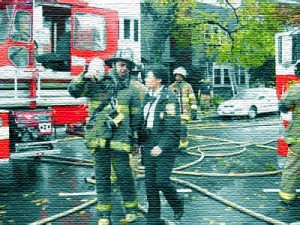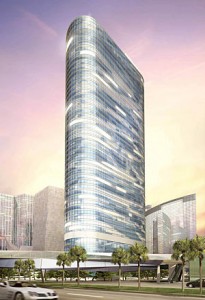2009-10-24: As I have travelled around … not just Ireland, but many other countries as well … it still remains a puzzle to me, today, why so many Fire Emergency Assembly Areas are located just outside the main entrance of a building. These locations are not safe in a ‘real’ fire emergency … and they should not even be used for the purposes of test/drill evacuations !
Is the guidance contained in current Building & Fire Regulations, Codes and Standards on what is a ‘Place of Safety’ in a fire emergency clear, simple, direct and precise ? Are you joking ? No way ! Let us take a few examples close to home …
In Ireland:
When you look at the array of different Technical Guidance Documents (Building Regulations) at the same time … TGD B (Fire Safety) is way out of proportion, in size, compared to all of the others. You would expect, therefore, to find exactly what you were looking for in that document. Wouldn’t you ?
TGD B (2006), Paragraph #1.0.9 – Definitions
Place of Safety
A place, normally in the open air at ground level, in which persons are in no danger from fire.
Clear as mud ! If there is a fire on O’Connell Street in Dublin … a person is safe on Patrick Street in Cork ! But, how is any Building or Facilities Manager expected to work with such a vague definition ?
In England & Wales:
No practical definition, as such, is readily provided. The nearest thing to a definition is an amalgam of the following …
Building Regulations, Requirement B1 – Means of Warning & Escape
The building shall be designed and constructed so that there are appropriate provisions for the early warning of fire, and appropriate means of escape in case of fire from the building to a place of safety outside the building capable of being safely and effectively used at all material times.
Approved Document B: Volume 1 – Dwellinghouses & Volume 2 – Buildings Other Than Dwellinghouses
The ultimate place of safety is the open air clear of the effects of the fire.
British Standard BS 9999 : Code of Practice for Fire Safety in the Design, Management & Use of Buildings : 2008
Place of Ultimate Safety
Place in which there is no immediate or future danger from fire or from the effects of a fire.
Again … all as clear as mud ! Again … how is any Building or Facilities Manager expected to work with such vague guidance ? Have you also noticed the additional obfuscation introduced by use of the word ‘ultimate’ in BS 9999 ?
It is hard to escape the conclusion that what is urgently needed is a fundamental transformation and re-shaping of the tired, antiquated and flawed ad-hoc assembly of prescriptive ‘solutions’ contained in current national building and fire regulations, codes, standards and administrative provisions … whatever their origin !
.
Now … try this for clarity, simplicity, directness and precision …
Place of Safety (Fire Incident in a Building, No Explosion Hazard*)
Any location beyond a perimeter which is [100]* metres from the fire building or a distance of [10]* times the height of such building, whichever is the greater
and
where necessary and effective medical care and attention can be provided, or organized, within one hour of injury
and
where people can be identified.
* Where there is a Risk of Explosion … multiply the numbers in square brackets above by 4.
Was that good for you ?
Furthermore …
The Route to any Place of Safety must be Accessible for All Building Users, including people who use wheelchairs, the visually impaired, frail older people, women in the later stages of pregnancy, children, etc., etc.

With regard to an Adequate, never mind a Proper, Awareness of Disability-Related Issues at a Fire Scene … it is shocking to realize how almost non-existent this is among Fire Services … not just in Ireland and Britain … but in the rest of Europe and North America as well.
Even a hint of criticism will usually … not always … meet the Neanderthal Fire Service Response: “Have you ever been in a ‘real’ building fire ?”
My Response is: “Do you have to be a hen to know when an egg is bad ?”
This discussion will continue later … have no doubt … that is a promise !
.
.
END










